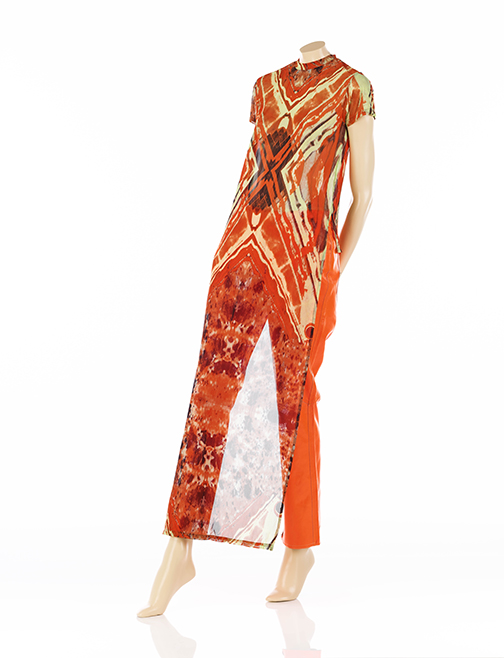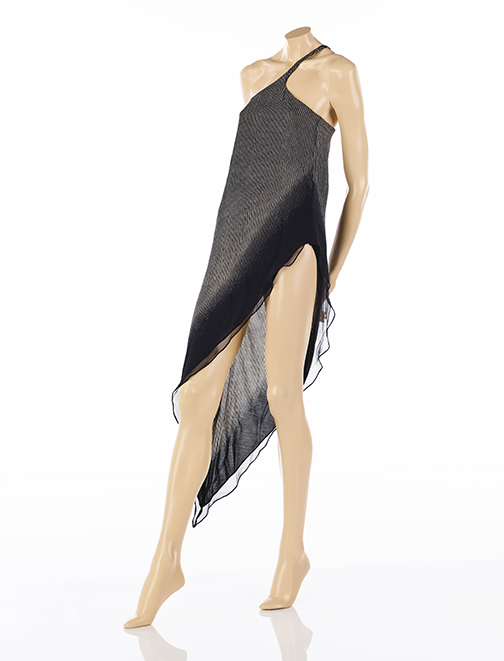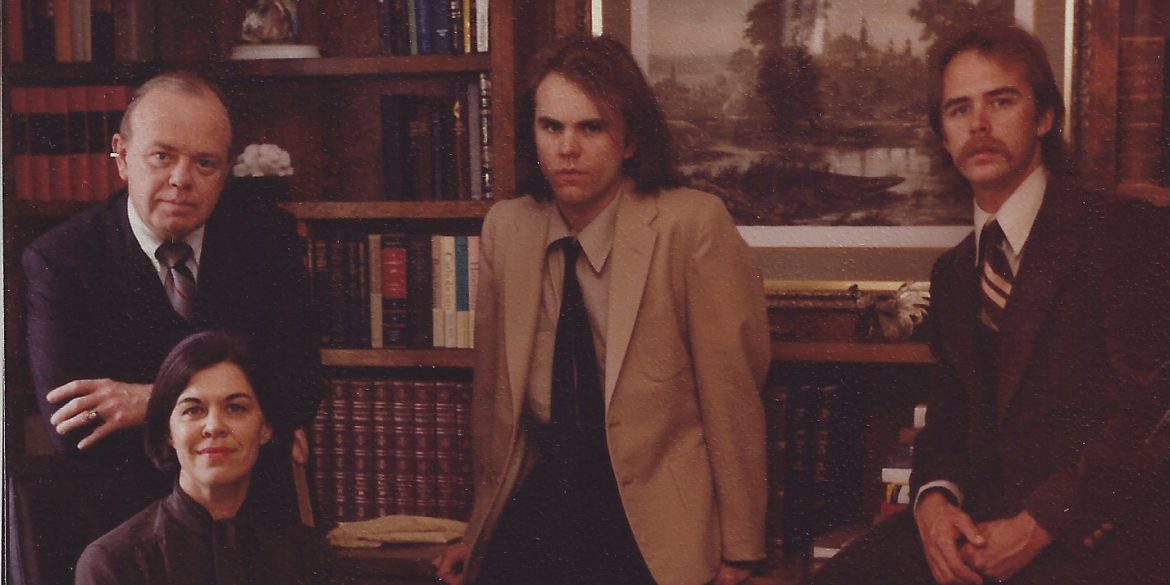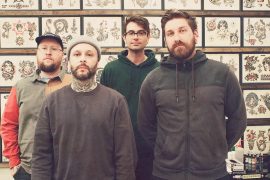At the Indianapolis Museum of Art at Newfields, a forthcoming fashion exhibit salutes Stephen Sprouse as a designer ahead of his time.
When the Stephen Sprouse: Rock | Art | Fashion exhibition opens at the Indianapolis Museum of Art (IMA) in July it’ll be a homecoming for the revolutionary Indiana fashion designer’s legacy. The welcome celebration began at the IMA in 2019 when Joanne Sprouse and Bradford Sprouse, his mother and brother, announced they were donating Sprouse’s entire fashion collection and archives to the museum.
It was a major coup for any museum, let alone one that devotes itself to collecting fashion by designers with Indiana roots, including Norman Norell, Bill Blass and Halston. “It was really important to us to add Stephen Sprouse’s work to our collection. His work belongs where it will be appreciated,” says Niloo Paydar, curator of textiles and fashion arts at the IMA. “We do appreciate it. I think [Mrs. Sprouse] knew that and felt that we were the best institution to steward his legacy.”
Throw in Sprouse’s frequent visits to the IMA as a child and young adult, the creative energy he expressed there and you have what can only be called a logical fit. The relationship began in 2012 after the IMA approached the Sprouse family with a request to borrow several designs for the 2013 exhibit An American Legacy: Norell, Blass, Halston & Sprouse.
Of course, the family could have gone elsewhere with the Sprouse collection. The Metropolitan Museum of Art or Fashion Institute of Technology come to mind since Sprouse spent 30 years living and working in New York. “I really thought New York City would be the spot,” says Brad Sprouse, a retired rancher who lives in northern Michigan. “But Mom, any time we’d get together to talk about things, it was ‘IMA this’ and ‘IMA that.’”
In the quest to find the right home for the collection, Brad began to see the merit of his mother’s wish to give it to the IMA. “First of all, they were very, very interested and excited about it,” he says. “That said something. But more importantly, I saw Stephen’s attraction to the museum. We were only 45 minutes from the museum in Columbus [Indiana]. Stephen was older and he got his driver’s license sooner. He would go up to the museum a lot to check out the exhibits, and he’d also bring a group of friends. They were just kids hanging out and having fun. Steve would dress them all and they would have photo shoots on the grounds by all the sculptures. He really liked it.”
With more than 60 pieces that highlight Sprouse’s career until his untimely death in 2004, Stephen Sprouse: Rock | Art | Fashion will display only a fraction of the fashion, sketches, media kits, Polaroids, slides, lookbooks, press clips and ephemera in the collection and archives. Catalogued with roughly 10,000 items, it’s the largest collection the IMA has ever received, and it’s already generating buzz among scholars and conservators who study the unique fabrics and couture cut and construction techniques Sprouse used in his garments.
Among the collection’s gems are two dazzling Sprouse portraits made by his friend Andy Warhol in 1984. Warhol became part of the designer’s inner circle after they were introduced through Halston.
Sprouse moved from Indiana to New York City in the early 1970s. There he became one of America’s most enduring and iconoclastic names in fashion. His designs are still coveted by collectors and the fashion cognoscenti, though they were occasionally panned by the fashion critics and tastemakers of the 1980s and 1990s.

Stephen Sprouse (American, 1953–2004), high-low blouse and pants “NASA collection,” Fall/Winter 1999–2000, leather, nylon, spandex, Velcro.
An inevitable artistic ascent
The Sprouse family moved to Columbus, Indiana when Stephen was two. At six, Stephen’s aesthetics were keen enough that his mother began to heed his fashion advice. By the time he was 10, there was little doubt that he would lead some kind of a creative life. “Stephen was born with unbelievable gift,” says Brad Sprouse. “His entire life, my brother could draw just about anything, and he had the knowledge to be uncompromising about how he wanted things to look, and that’s what he was going to get.”
In 1966 Stephen’s savvy parents, Joanne and Norbert Sprouse, were convinced that their precocious eighth-grader might just be America’s next big fashion designer. Why not? He was already drawing complete collections.
The Sprouses weren’t prone to squander time, talent or opportunity. What’s a good parent to do with a child who shows such promise? They hastened to get a more objective opinion of their son by setting up meetings with two of the biggest names in fashion: Indiana’s own Norman Norell and Bill Blass.
International Herald Tribune (IHT) reporter Eugenia Sheppard witnessed the family’s encounter with Blass, which occurred the day after Norell gave them an audience. In the September 9, 1966 edition of IHT, Sheppard describes Stephen Sprouse as, “a good-looking boy, still in the slightly chubby stage. He is pink-cheeked and wholesome, with a shock of hair over half his forehead. His blue eyes, fringed all around with black lashes, traveled around the room with great interest but not a trace of shyness or awe.”
One thing led to another, and by the time Stephen was in high school, he was working in New York during the summer months. “I don’t think he got paid a penny,” Brad Sprouse says. “We had some friends in New York City where he stayed, and someone looking over him and helping him around that madhouse.”
Sprouse had various summer apprenticeships in New York; never was he relegated to menial work. Bill Blass, Halston and other designers were interested in his ideas and used his talent. “He got a lot of good press, and I think both my parents, particularly my father, saw the potential in [fashion] as a livelihood.”

Stephen Sprouse (American, 1953–2004), dress, ‘scan lines,’ 1979, silk chiffon, silk jersey.
Pioneer of punk-rock grunge and urban street fashion
In 1971, fresh out of high school, Sprouse enrolled in the Rhode Island School of Design. He stayed one semester, then dropped out and went to work as Halston’s main assistant. Two and a half years later, Sprouse left Halston and began doing his own thing: steeping himself in rock and underground music, designing clothes, making art and developing friendships that formed his coterie, including singer Debbie Harry, a downstairs neighbor with whom he shared a kitchen and a bathroom. Harry credits Sprouse with developing the signature style that defined her public image.
When it was time to name the forthcoming show at the IMA, Paydar drew inspiration from Sprouse’s artistic trifecta. “In one interview he says that his passions are rock, art and fashion, and that he chose fashion because he wasn’t good in the first two,” Paydar says. “What he did was very different in New York at the time, and that’s why people took notice when he started designing for Debbie Harry.”
The first collections to distinguish Sprouse as a bonafide fashion designer came in 1983 and 1984. Sprouse’s graffiti prints, Day-Glo colors and spectacular fashion shows challenged an industry that was stale next to his imaginative standards. “People were like, ‘Oh, my God, who is this kid, who is this kid?’” Paydar says.
Sprouse’s career was a rollercoaster ride with peaks, valleys and multiple bankruptcies caused mainly by a limited business prowess that prevented him from consistently cashing in on his talent. When it came to sourcing the materials and construction of his clothes, shoes and accessories, Sprouse spared no expense, which often made his designs unaffordable to the most interested clientele. “He knew how they would be made and what they would be made out of, and that was the bottom line,” says Brad Sprouse. “He wasn’t going to save 75 percent on some necklace. He knew how he wanted it to look, and he was unwilling to compromise in any way that took him away from his vision.”
Building a fortune was never on Sprouse’s menu of interests, according to his brother Brad. “At the end of the day, he was all about friendships, integrity and commitment to his artistic vision,” he says. “As I’ve gotten older and learned more about the industry, I could not admire him more for the uncompromising attitude and direction he kept his entire life.”
*
Stephen Sprouse: Rock | Art | Fashion runs July 16, 2022 – April 2, 2023.



